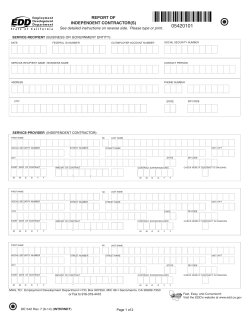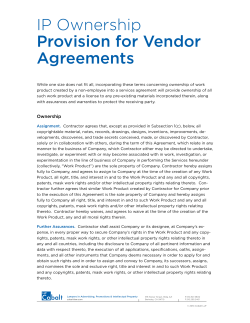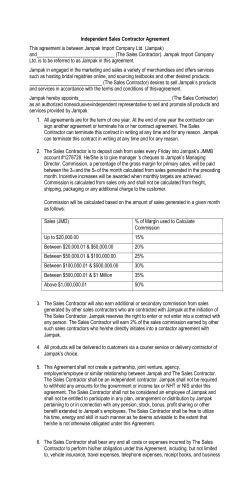
Air-Conditioning Buying Guide
Air-Conditioning Buying Guide Buying a new air-conditioning system is a big decision. This Air-Conditioning Buying Guide can help you make the right choice, save energy and money. Shop with confidence for a new air-conditioning system With a new air-conditioning system, you can enjoy the cost savings that come from increased energy efficiency year after year. And when you purchase your system through a Participating Independent Contractor,* you can benefit from valuable rebates. A Participating Independent Contractor* will recommend the most cost-effective solution for you and will install the system to meet FPL’s service standards. Expert information and advice Most consumers may not know what airconditioning products to buy or whom to call to install them. *S ee last page for details regarding Participating Independent Contractors. Benefits When you have the right air-conditioning system, you’ll enjoy: Increased energy efficiency Cost savings before and after the purchase Installation by a qualified contractor Confidence that you made the right decision The good feeling that comes from helping improve the environment Costs and savings breakdown To determine the type of system you can best afford, find out: »» The system’s total cost – including purchase price, installation and monthly operating costs. A high-efficiency system may cost more initially, but saves you money in the long run. »» The differences between systems – use the enclosed worksheet to compare the air-conditioning units you’re considering. »» You should also compare and consider: unit size, price, efficiency rating, FPL rebates available, estimated yearly operating cost, annual savings and payback period. Terminology Straight cool system – an air-conditioning system that includes a cooling cycle only. Gas, oil, or electric strip heating may be included in straight cool systems. Strip heating (or resistance heating) – a form of electric heating, which may be used in climates where heat is used infrequently. Air is blown over electrically heated metal coils and circulated into the living space. Heat pump system – cooling and heating system that provides a cooling cycle during the summer and a heating cycle during the winter by absorbing heat from the outside air and transferring it inside. Heating is provided at about half the cost of electric strip heating. SEER (Seasonal Energy Efficiency Ratio) – a measure of average annual cooling efficiency of an air conditioner or heat pump. FPL recommends a minimum SEER of 14.0. HSPF (Heating Seasonal Performance Factor) – a measure of average annual heating efficiency of a heat pump. FPL recommends a minimum HSPF of 6.8. The higher the SEER or HSPF, the more efficient the model. Units of measure that determine an air-conditioning system’s size are: » B TU (British Thermal Unit) – used to describe how much cooling or heating a home needs. » T on – a measure of the size or cooling capacity of an air conditioner. One ton is equal to 12,000 BTU. Three easy steps to evaluate your air-conditioning system Comparison Worksheet When shopping for a new air-conditioning system, FPL recommends buying a high-efficiency unit. While it may cost more initially, ultimately the unit will pay for itself with the money you’ll save on your electric bill. To determine the payback period for a high-efficiency unit versus a standard/lower-efficiency unit, simply work with your contractor and fill in the appropriate information for each step below. Step 1: Price Enter the price of both units from the contractor and then subtract the FPL rebate amount from each. The rebate amount can be found in Table 1 in this guide. This gives you the price of each system. Unit 1 Unit 2 Lower-efficiency unit Higher-efficiency unit Brand name: Brand name: Size: BTUh Price: – FPL Rebate: – Other Rebate: – Gov. Incentive: = Size: $ Price: $ Take the price of unit 2 (higher efficiency) and subtract the price of unit 1 (lower efficiency) to determine the price difference. Step 3: Operating Cost Difference Refer to Table 2 in this guide for operating cost information. Then take the operating cost of unit 1 (lower efficiency) and subtract the operating cost of unit 2 (higher efficiency). This gives you the operating cost difference. Step 4: Payback Take the price difference from Step 2 and divide it by the operating cost difference from Step 3 to determine how many years it will take to recover the money you’d spend on a high-efficiency system. – FPL Rebate: $ – Other Rebate: $ – Gov. Incentive: Actual: $ Step 2: Price Difference BTUh Unit 2 actual price: $ Unit 1 actual price: $ – = = Actual: $ $ $ $ $ Difference in price: $ Unit 1 operating cost: $ per year Unit 2 operating cost: $ per year Difference in operating cost: $ per year Difference in price: $ Difference in operating cost $ – = ÷ = Payback in years: R377-1203_22910 How central air conditioners work Air conditioners cool your home by removing heat from the indoor air and transferring the heat to the outdoor air. The vehicle your system uses to carry the heat is either a refrigerant, commonly referred to as Freon, or water. » Warm inside air (1) enters the indoor unit or air handler via return ducts and dust particles are removed through a filter (2). » Excess moisture condenses on the outside of the coils and is carried away through an evaporator drain line. » Through the refrigeration cycle, the condensing or outdoor unit releases heat (6) from the home to the outside air. » A blower (3) in the indoor unit moves the warm air past an evaporator coil (4), which cools and dehumidifies the air. » The cooled air is sent through a duct system (5) to circulate conditioned air through the home. » The outdoor unit’s compressor and coil turn the hot gas from the indoor unit back to a cool liquid, sending it back to the inside unit’s evaporator coil. SPLIT-SYSTEM AIR-CONDITIONING UNIT Warm air return duct 1 Warm inside air Warm air 5 Duct Cool air Heat removed from indoors Cool inside air 6 Cool evaporator coil 4 Fan INDOOR AIR HANDLING UNIT Evaporator drain line Outdoor coil Compressor 2 Filter** 3 Blower **Change filter regularly using proper size, or clean it monthly. R377-1203_22910 Heat pump air conditioning: a smart choice for temperate climates A new air-conditioning system can provide a number of benefits including greater comfort and increased energy efficiency, which may save you money while also improving the environment. If you live in an area of Florida where regular winter heating is needed, FPL encourages you to consider a heat pump air conditioning system. A heat pump system is a central air conditioning system that has the ability to provide a cooling cycle during the summer and a heating cycle during the winter. Benefits » Includes cooling and heating equipment » Depending on how warm you want your home in the winter and how cold it is outside, heat pumps may heat your home at about half the cost of conventional electric strip heating » Lower energy usage is better for the environment How heat pumps work » A heat pump system transfers heat between your house and the outside air. » In summer, heat is removed from your house and the air is chilled and circulated throughout the home. Choose the system that is best for you Buying a new central air-conditioning system is a big decision. Heat pump systems can cost more for the purchase and installation; however, depending on your heating needs and your winter climate, some customers may realize value after the initial investment through lower energy usage costs. A Participating Independent Contractor* can help you determine if a heat pump system is right for you. Additionally, when you purchase and install a complete high-efficiency system from a Participating Independent Contractor, you’ll receive an FPL rebate lowering the overall purchase price. To view a list of Participating Independent Contractor’s, visit www.FPL.com/contractor. » In winter, this process is reversed. Heat is removed from the outside air and used to warm the indoor air as it is circulated through your home. » Heat pump technology can extract heat energy from air as cool as 40 degrees to warm the inside of your house. *The list of participating independent contractors (PICs) is a compilation of businesses that have agreed to comply with FPL's Program Standards, and is not a recommendation by FPL of a particular independent contractor. The decision to select, hire and the management of the participating independent contractor is the sole responsibility of the FPL customer. THE PIC IS NOT AN AGENT OR JOINT VENTURER AND IS NOT EMPLOYED BY AND DOES NOT WORK FOR FPL. FPL DOES NOT MAKE AND EXPRESSLY DISCLAIMS ANY WARRANTY, GUARANTEE, OR PROMISE, WHETHER EXPRESSED OR IMPLIED, INCLUDING, WITHOUT LIMITATION, ANY IMPLIED WARRANTY OF MERCHANTABILITY, FITNESS FOR A PARTICULAR PURPOSE, THE AMOUNT OF ENERGY SAVINGS TO BE ACHIEVED, THE SUITABILITY OR QUALITY OF MATERIALS TO BE INSTALLED BY, OR THE WORKMANSHIP OF THE PARTICIPATING INDEPENDENT CONTRACTOR SELECTED AND HIRED BY THE FPL CUSTOMER. R552-1211_25293 How heat pumps work Heat pumps heat your home by removing heat from the outdoor air and transferring the heat to the indoor air. The vehicle your system uses to carry the heat is called the refrigerant. » Cold inside air (1) enters the indoor unit or air handler via return ducts and dust particles are removed through a filter (2). » A blower (3) in the indoor unit moves the cold air past the heated indoor coil (4), which warms the air. » The warmed air is sent through a duct system (5) to circulate conditioned air through the home. » Through the refrigeration cycle, the outdoor unit recovers heat (6) from the outside air and transfers it to the home. SPLIT-SYSTEM HEAT PUMP UNIT Return duct 1 Cold inside air Warm air 5 Duct Cool air Cool inside air Warm air supply Heated indoor coil 4 Heat removed from outdoors Fan INDOOR AIR HANDLING UNIT 6 Evaporator drain line Outdoor coil Compressor 2 Filter** 3 Air Blower **Change filter regularly using proper size, or clean it monthly. R552-1211_25293 Size or cooling capacity EER Efficiency Rating BTUh 13.0 - 13.99 <15,000 $50 $85 $115 $140 $160 $180 $200 15,00 - 20,999 $80 $130 $170 $210 $240 $270 $295 21,000 - 26,999 $110 $170 $230 $285 $325 $360 $395 27,000 - 32,999 $135 $215 $280 $355 $400 $450 $495 33,000 - 38,999 $165 $265 $340 $425 $480 $540 $595 39,000 - 44,999 $190 $300 $400 $495 $565 $630 $690 45,000 - 50,999 $215 $350 $469 $565 $640 $720 $790 51,000 - 56,999 $245 $390 $520 $635 $730 $810 $890 57,000 - 64,999 $275 $430 $575 $705 $805 $910 $1,000 $400 $555 $700 $830 $930 $1,035 $1,125 14.0 - 14.99 15.0 - 15.99 Residential air conditioning > 65,000 16.0 - 16.99 17.0 - 17.99 18.0 - 18.99 Air-cooled equipment - straight cool and heat pumps 19.0 + Table 1 Size or cooling capacity SEER Efficiency Rating BTUh 14.0 - 14.99 <21,000 $125 $220 $305 $390 $445 $500 $570 21,000 - 26,999 $140 $265 $405 $515 $585 $670 $755 27,000 - 32,999 $165 $320 $500 $640 $740 $840 $950 33,000 - 38,999 $210 $375 $585 $770 $880 $1,005 $1,130 39,000 - 44,999 $265 $475 $685 $895 $1,035 $1,175 $1,330 45,000 - 50,999 $305 $545 $780 $1,020 $1,175 $1,340 $1,510 51,000 - 56,999 $375 $640 $895 $1,145 $1,330 $1,510 $1,705 57,000 - 64,999 $430 $725 $1,005 $1,285 $1,495 $1,705 $1,930 15.0 - 15.99 16.0 - 16.99 17.0 - 17.99 18.0 - 18.99 19.0 - 19.99 20.0 + EER Efficiency Rating BTUh > 65,000 12.0 - 12.99 13.0 - 13.99 14.0 - 14.99 $585 $1,105 $1,375 15.0 - 15.99 $1,650 16.0 - 16.99 17.0 + $1,900 $2,100 R378-1203_22911 Annual cooling cost comparison Typical savings from replacing an existing air conditioner Table 2 Size or cooling capacity Annual cost to cool your home if the SEER of the existing unit is FPL Recommended High-Efficiency Systems Annual cost to cool your home if the SEER is 13 14 15 16 17 18 19 20 $590 $550 $510 $470 $450 $420 $400 $370 $360 $810 $740 $680 $640 $590 $560 $520 $490 $470 $450 $1,070 $970 $890 $820 $760 $710 $670 $630 $590 $560 $530 42,000 $1,250 $1,130 $1,040 $960 $890 $830 $780 $730 $690 $660 $620 4 48,000 $1,420 $1,300 $1,190 $1,100 $1,020 $950 $890 $840 $790 $750 $710 4.5 54,000 $1,600 $1,460 $1,340 $1,230 $1,140 $1,070 $1,000 $940 $890 $840 $800 5 60,000 $1,780 $1,620 $1,480 $1,370 $1,270 $1,190 $1,110 $1,050 $990 $940 $890 10 11 12 $710 $650 30,000 $890 3 36,000 3.5 Tons BTU/h 2 24,000 2.5 (1990s) (code minimum 2006) Example: Annual cooling cost to run a 3-ton (36,000 BTU/Hour) installed in the 1990s with a 10 SEER will be $1,070. If replaced with a new 16 SEER system, the cost drops to $670 - a savings of $400 per year. Costs above are estimates based on South Florida area average of 2,800 annual A/C cooling operating hours and current 10.6 cents per kWh. R378-1203_22911 1 Determine if you need a new system Air-conditioning energy costs can account for more than 50 percent of your electric bill during peak heating and cooling months. So before you spend money to repair your air-conditioning system or invest in a new one, consider these questions to help evaluate the condition of your existing system: »» Does your system undergo frequent repairs? »» Has your system experienced a major component failure? »» Are you continually receiving high electric bills? »» Is your air conditioner working harder to keep your home cool? If your system is more than 10 years old and you answered yes to any of these questions, you may benefit from replacing your system and taking advantage of lower long-term costs. 2 Evaluate your options Key information you’ll want your contractor to provide before making a final decision: »» Estimate – have your contractor prepare a written estimate that includes: –– System type – straight cool or heat pump? –Efficiency – what efficiency rating is recommended? –Size – a heat load calculation will determine the correct size – FPL rebates – rebate amounts – Additional rebates – are other rebates available? –Warranty – how long are parts and labor covered? –Price – be sure final costs include any changes to your home’s electrical or duct system and ask if duct size is appropriate for your new system »» Efficiency Extras – ask your contractor these important questions: –– Are preventive maintenance programs available? –– Will a programmable thermostat help you save even more? –– Does your duct system have holes or leaks that need repair? –– Is your home’s ceiling sufficiently insulated? 3Choose the system that’s right for you When shopping for a new air-conditioning system, it’s important to find one that best fits your household’s needs. The main types of systems to consider are: »» Straight cool system –– An air-conditioning system that includes cooling equipment only –– A gas, oil or electric strip heater may be included in this type of system »» Heat pump system –– Includes cooling and heating equipment –– Heats your home at about half the cost of conventional electric strip heating –– Costs slightly more than a straight cool system –– Most suitable for homes in Central and North Florida An FPL rebate to help get you started When you purchase and install a complete (both indoor and outdoor) high-efficiency system from a Participating Independent Contractor*, you’ll receive an FPL rebate toward the purchase price. We will provide a list of Participating Independent Contractors*. From there, you can select the one that’s right for you. To obtain our Participating Independent Contractor lists*, simply log on to www.FPL.com/contractor or call us at 1-800-DIAL FPL (1-800-342-5375). *The list of Participating Independent Contractors (PICs) is a compilation of businesses that have agreed to comply with FPL’s Program Standards, and is not a recommendation by FPL of a particular independent contractor. The decision to select, hire and the management of the Participating Independent Contractor is the sole responsibility of the FPL customer. THE PIC IS NOT AN AGENT OR JOINT VENTURER AND IS NOT EMPLOYED BY AND DOES NOT WORK FOR FPL. FPL DOES NOT MAKE AND EXPRESSLY DISCLAIMS ANY WARRANTY, GUARANTEE, OR PROMISE, WHETHER EXPRESSED OR IMPLIED, INCLUDING, WITHOUT LIMITATION, ANY IMPLIED WARRANTY OF MERCHANTABILITY, FITNESS FOR A PARTICULAR PURPOSE, THE AMOUNT OF ENERGY SAVINGS TO BE ACHIEVED, THE SUITABILITY OR QUALITY OF MATERIALS TO BE INSTALLED BY, OR THE WORKMANSHIP OF THE PARTICIPATING INDEPENDENT CONTRACTOR SELECTED AND HIRED BY THE FPL CUSTOMER. R170-1106_22779
© Copyright 2025
















